7.2 /10 1 Votes7.2
Director(s) Yoshinori Kawano Composer(s) Makoto Tomozawa Initial release date 18 December 1997 | 7.2/10 GameSpot Designer(s) Kazunori Kadoi | |||||||||||||||||||||||||||||||||
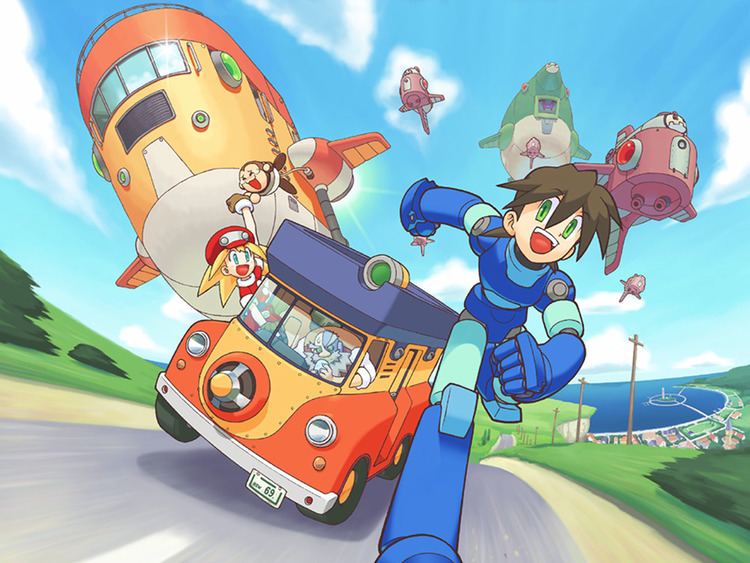 | ||||||||||||||||||||||||||||||||||
Producer(s) Keiji InafuneYoshinori Kawano Writer(s) Yoshinori KawanoShin Kurosawa Platforms Genres Action-adventure game, Third-person shooter Similar Mega Man Legends games, Capcom games, Adventure games | ||||||||||||||||||||||||||||||||||
Mega Man Legends, known in Japan as Rockman DASH Hagane no Bōkenshin (ロックマンDASH 鋼の冒険心, Rokkuman Dasshu Hagane no Bōkenshin, lit. "Rockman DASH Adventurous Spirit of Steel"), is an action-adventure shooter game released by Capcom. It is the first game in the Mega Man Legends sub-series of Mega Man games from Capcom, and the first major 3D polygonal Mega Man title released in the franchise. It was released on the PlayStation in 1997 in Japan and in 1998 in North America. A Nintendo 64 port was released in 2000 with the same title, but it was renamed Mega Man 64 for the English release in 2001. Another port was released for Microsoft Windows in 2001, and PlayStation Portable in 2005, with the latter exclusively in Japan.
Contents
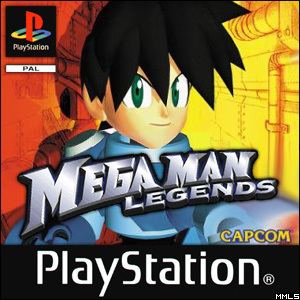
It stars a different spiritual incarnation of Mega Man named Mega Man Volnutt, the game's playable character. Mega Man Volnutt is a "Digger", a person in charge of investigating ruins from a flooded Earth. During his journey with his friends, their ship crashes in Kattelox Island, where Mega Man decides to confront pirates who are attacking it to obtain its hidden treasure. As an action-adventure game, Mega Man Legends's gameplay is very different from the ones of the original series despite sharing a few elements.
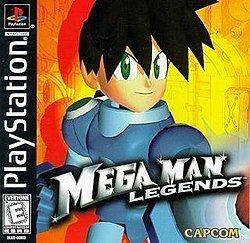
The game was produced by Keiji Inafune who remarks that he and the Capcom staff enjoyed designing the game. Since its original release Mega Man Legends has received positive critical response due the series jump from 2D graphics to 3D. Ports for the Nintendo 64 and Windows received negative comments for lacking updates from the PlayStation version whose graphics were considered outdated by the time the ports were released. Nevertheless, critics have praised Mega Man Legends as an enjoyable game in the Mega Man series. Mega Man Legends was followed by the prequel The Misadventures of Tron Bonne and a sequel titled Mega Man Legends 2.
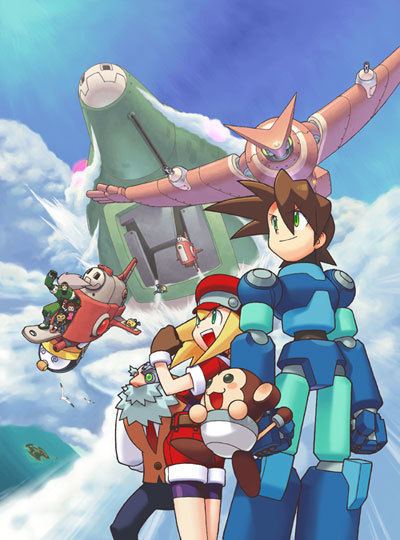
Gameplay
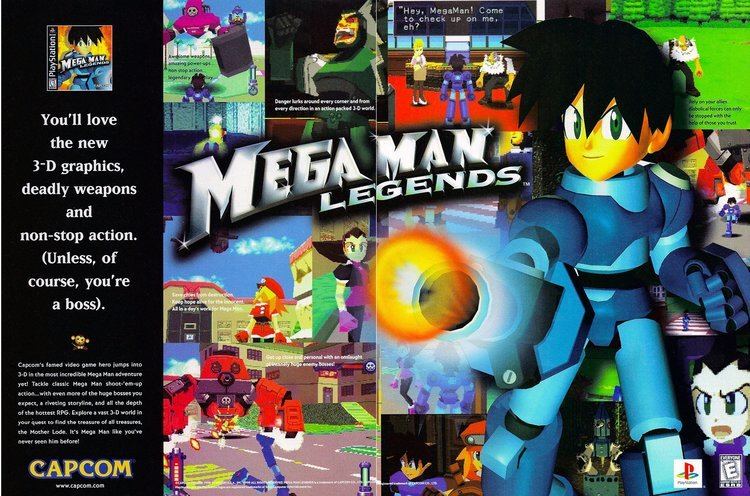
Mega Man Legends differs greatly from the platforming gameplay of past Mega Man games, the main factor being the three-dimensional worlds, and three-dimensional movement therein. Unlike the original Mega Man series which are platform games, Legends is an action-adventure game with elements like lock-on targeting, which was later made popular by games such as The Legend of Zelda: Ocarina of Time. The player controls Mega Man Volnutt across the title, in which he has to complete different missions such as investigating ruins or fighting pirates. The player travels through a large world, with various dungeons that are explored in a certain order, as well as a town with non-player characters to talk to. As such, the plot is revealed through cutscenes.
Although the only way to move in the game is on foot, once Roll Caskett repairs a support car, she is able to directly take Mega Man to specific areas. In Legends, large gems called Refractors are used as a power source. Small shards of them can be exchanged for money, and in the game, enemies that are destroyed will often drop these Refractor Shards. When shards are picked up, the equivalent amount of Zenny, the game's basic unit of currency, is added automatically. The health of Mega Man can be increased through the game in the shops, while it can be recovered through packs bought at shops, obtaining red spheres from defeated opponents or by asking the character Data to recover Mega Man's health. Mega Man also has a Life Shield which reduces the damage that he can receive from enemies. The damage caused by enemies can also be reduced by obtaining upgrades to Mega Man's armor or his helmet. Mega Man's interactions with characters from the game can also affect the price of objects. If the player makes Mega Man be rude with characters, prices from objects will be increased and the dialogues with people will also change.
The power of Mega Man's main weapon - the Buster Gun - depends on Buster Parts equipped. Buster Parts can be equipped to upgrade four stats of the Buster Gun; Attack (how strong it is), Rapid (how fast it fires), Range (how far the shots go), and Energy (how many shots can be fired before stopping). Buster Parts can be retrieved from stores or from dungeons. Additionally, Roll is able to create Buster Parts from unusable objects found in the ruins. Roll is also able to make weapons for the player, using specific combinations of parts that can be found in dungeons or bought in shops. Many of these weapons supplement the Buster Gun. The only way to refill them in the field is an item that can be bought, but only one can be carried. Only one special weapon can be equipped at a time, and the only way to switch is to talk to Roll, unlike the original series. Special weapons can be upgraded, and have five stats; Attack, Rapid, Range, Energy, and Special. In order to upgrade them, the player must pay a specific amount of Zenny.
Setting and characters
The Legends series takes place on a flooded Earth. Because of the flooding, only a few sparse islands exist and energy sources are rare. In order to satisfy this increasing demand for energy to power up machinery, quantum refractors found in ancient ruins are used. These refractors are valuable; they serve as an energy source, and their shards are used as currency. However, the main goal of every person is to find the Mother Lode, an item of supposed infinite power that can fill the need for the energy in one swoop. Those who try to excavate these ruins are called "Diggers" ("Digouters" in the Japanese version). The protagonist of the game is Mega Man Volnutt, a Digger living in a ship called Flutter. He lives there alongside Roll Caskett, his Spotter who is searching for her missing father, Barrel Caskett, Roll's grandfather, and Data, a mysterious monkey that talks in gibberish only Mega Man himself can understand. The game's antagonists are pirates known as the Bonnes who want to steal Kattelox's secret treasure in order to become rich. They consist of Teisel Bonne, the leader of the group. His sibling is Tron Bonne, who builds most of their robots used in their elaborate schemes (and develops feelings for Mega Man), and the youngest brother, Bon Bonne, who can only say one word—"Babu!" The Bonnes are accompanied by forty Servbots, robots under the care of Tron.
Story
The game begins with Mega Man Volnutt trying to exit a ruin after finding the refractor inside. After dealing with the Reaverbots blocking his way out, he makes his way to the Flutter, which leaves the ruin. However, the Flutter experiences some engine problems and crash lands on Kattelox Island. From there, the Casketts try to find a way to repair their ship. However, when the pirates the Bonnes attack Kattelox's city with giant mechanical weapons, Mega Man decides to stop them. Once Mega Man is able to defeat each member individually, Kattelox's mayor, Amelia, tells Mega Man the Bonnes are searching for the island's secret treasure and that it is said if somebody obtains it, a great disaster will befall the island. Amelia asks Mega Man to explore the island's ruins in order to investigate it. With a refractor found in a ruin, Roll and Mega Man are able to repair the Flutter, allowing them to find a cave to continue exploring the island. While exploring the cave, Mega Man activates the Main Gate, a dungeon where he should be able to find the reason why Reaverbots from the island are being activated. Before being able to enter into the Main Gate, Mega Man once again confronts the Bonnes who, after being defeated once again, decide to let Mega Man enter the Main Gate, hoping he will bear the brunt of the work then planning to steal the treasure from him afterward.
When Mega Man enters the Main Gate, he discovers it is actually a stasis chamber for the robot Mega Man Juno, a 3rd class bureaucratic unit from Eden, a space station orbiting above the planet. When he is accidentally awakened from his sleep by Mega Man, Juno makes many strange revelations, among them referring to Mega Man as "Mega Man Trigger", and realizing that Mega Man is suffering from memory loss. Juno claims that the island's population needs to be purged so it will be more controllable, and confronts Mega Man when he tries to stop him. After a struggle, Juno is defeated and dies. Even with Juno's physical body gone, he transfers his backup data into the systems of Eden, preventing the halt of the Carbon Purification Process. Data gives new commands to the system, stopping the Purification and also deleting Juno's backup data from Eden. Data then reveals to Mega Man that he contains all of his previous memories from when he was Mega Man Trigger. Mega Man had stored his memories into Data as a way to prevent Eden from ever tampering with it. Data promises that he will restore Mega Man's memory when the time comes. The residents proclaim Mega Man a hero and the Caskett family rides off in the repaired Flutter to continue their journey. In a post-credit scene, the Bonnes are seen sailing on a vessel built by Tron out of the scraps from the Gesellschaft, with the refractor from the main gate and Bon Bonne in tow.
Development and release
Producer Keiji Inafune stated that while designing Mega Man Legends, he and the staff wanted it to be entertaining for gamers. He stated that the game did not sell well as it was too early released, but nevertheless, Inafune comments "If we made it at the present time in modern quality, I believe that it would have sold a lot better". Inafune stated his purpose was creating a new Mega Man which would be completely different from all the others. Wanting that game to entertain gamers from all the ages, Inafune decided to mix the action, RPG and adventure genres. He also wanted to add more animation to the game and let the voice actors do various scenes. However, while designing the title Inafune was still doubting whether Mega Man Legends would be an entertaining game. A demo of the game was originally included in the Japanese director's cut version of Resident Evil. In the demo, the game had the title of "Rockman Neo" (ロックマン NEO). The game was released in Japan on December 18, 1997, while a re-release with the label of "PlayStation the Best" was published on May 4, 1999. The Soundtrack was composed by Makoto Tomozawa whose purpose was to add various theme songs. The sound designers found challenging making the sounds for the game with Toshio Kijno having never worked in a Mega Man title or Kawakami Tomoyuki finding it thought to the cut-scene animations. The theme for the Japanese version of the game is "Another Sun" and the ending theme is "Anata no Kaze ga Fuku kara" (あなたの風が吹くから, lit. "For Your Winds Shall Blow"), both by Reika Morishita. On February 21, 1998, Capcom published a CD of the game called Rockman Dash Original Soundtrack (「ロックマンDASH」 オリジナル・サウンドトラック). It contains a total of 40 tracks including the opening and ending themes. Tomozawa notes that the CD still lacks other tracks from the game due to the large number of tracks it had.
In December 1997, Capcom USA's President, Bill Gardner, told IGN that Mega Man Legends would be ported to the Nintendo 64. Although the title at that time was "Mega Man Neo", Gardner stated the title was not decided. In January 1998 the game was renamed " Mega Man Nova" as the general consensus did not find the previous name appealing. The game was released abroad as Mega Man Legends, title which was confirmed in March 1998. By April 1998, the English adaptation of the game was finished, but Capcom decided to delay its release until September of the same year, believing it would fit better during the holiday seasons. The English localization removed an option from the original game in which Mega Man protects Tron from a dog chasing her; while in the Japanese version, Mega Man could either kick or calm the dog, in the English release he could only calm to the dog. Other changes to the English version were the renames of character such as the protagonist Mega Man Volnutt's whose original name is Rock Volnutt. The PC port of the game was first announced by Capcom in the Tokyo Game Show from April 2000 alongside Dino Crisis and Resident Evil 3: Nemesis. The PlayStation Portable version of Mega Man Legends was released in Japan on August 4, 2005. It was re-released on December 21, 2006 and January 29, 2009, with the latter also including the PSP port of Mega Man Legends 2. Although a North American release of the port was planned, it was cancelled.
Reception
Since its release, Mega Man Legends has received mixed critical response from video game publications although the ports for Nintendo 64 and PC received from mixed to negative comments. GameRankings had an average of 73.73% for the PS version. The PC and Nintendo 64 version had lower averages of 33.67% and 63.94%, respectively. On Metacritic, the Nintendo 64 port holds an aggregate 59 out of 100 based on six reviews The jump from a 2D platform video game series to a 3D action-adventure game was well received, as reviewers compared it with other video game franchises whose changes were overall negative. Despite the change, critics liked how Legends shares various elements from the original Mega Man series. Game Informer liked the variations of Mega Man's special weapons as "There is plenty of shoot-em-up action for fans of traditional Mega Man titles." The storyline of the game was also praised, being labelled as "solid" by Game Informer and "engrossing" by GamePro, the latter praising the bosses characters as one of the best ones from the whole series. On the other hand, the game's difficulty received mixed reviews with focus on the boss battles, but praise in the addition of a tutorial mode later added to the Nintendo 64 port.
The N64 port, however, received criticism by Famitsu for being too similar to the original game. IGN commented that the PlayStation game "was a poor experience", asking "why Capcom [...] decided to make Nintendo 64 owners suffer through it unchanged". GameSpot thought that the graphics were outdated and that apart from not having any update from the original game, some music and sound clips were lost during conversion. The PC version received a more negative review; GameSpot gave it a "bad" 3.6 out of 10 stating gamers would find the PlayStation port more worthwhile. Similarly to Famitsu's review of the Nintendo 64 port, GameSpot complained about the lack of additions to the PC port. The PC's conversions of the cutscenes during the game were found to have a mistake which makes a character start a dialogue while another one is still talking.
In a 2007 retrospective of the Mega Man series, Jeremy Parish of 1UP.com ranked Mega Man Legends as "Worth it!", with praise focused on the setting, the plot, the English voice acting and the boss battles. GamesRadar shared similar opinions, stating "it was a complete overhaul in every way" and noting that its jump to 3D graphics "seems totally lost in this day and age..." On the other hand, ScrewAttack placed Mega Man Legends fourth in their article, "Top Ten Worst 2D to 3D Games", with criticism focused in the game controls, the camera, and the main character's voice. Allgame mentioned that while the game "had some significant problems that kept it from being anything more than a diversion" with its most notable one being the controls which were improved in the sequel. Mega Man's design was third in GamePro's "The 8 Worst Game Character Makeovers Ever" in which the author Patrick Shaw commented that having Mega Man without a helmet "just doesn't work". GamesRadar's article "Gaming's most absurdly oversized limbs" featured the game as an example of games with characters' oversized arms. In 2008, Joystiq's Wesley Fenlon listed Mega Man Legends as a potential game to be ported for the Wii with comments focused in the game's and the console's controls. In December 1998, a Capcom representative stated that Mega Man Legends became a very popular game, and due to this, the staff decided to release the spin-off The Misadventures of Tron Bonne.
